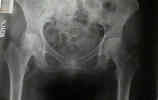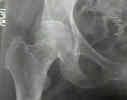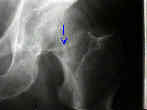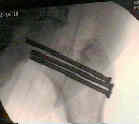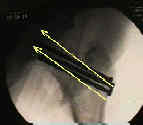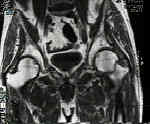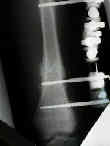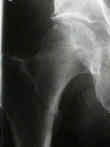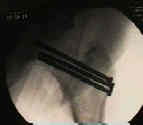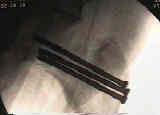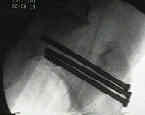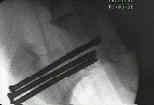- See: Garden Alignment Index
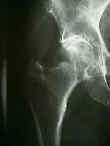
- Garden I:
- incomplete or impacted fracture, in which the trabeculae of the inferior neck are still intact;
- femoral head is tilted in a posterolateral direction, causing vaglus angulation at the frx site;
- non surgical treatment:
- some advocate non operative treatment for these injuries, noting that the frx is incomplete and
results in spontaneous healing in over 80% of patients;
- however, these fractures are often painful, and that cannulated screw fixation offers substantial and
immediate pain relief;
- ref: [Femur-neck abduction fractures.]
- Not All Garden-I and II Femoral Neck Fractures in the Elderly Should Be Fixed
- surgical treatment of garden I:
- no attempt is made to disimpact the fracture;
- fixation is performed w/ cannulated screws in situ;
- as an alternative consider use of multiple pins
- larger implants, such as compression hip screws or other nail plate devices, may increase risk of disimpaction at surgery and
are to be avoided;
- surgery can be performed on a fracture table or can be performed in the lateral position on a flouro table;
- if surgery is to be performed in the lateral position, then the lateral radiograph is obtained by flexing and externally
rotating the hip (frog leg lateral);
- note that it not uncommon to find that the fracture displaces into retroversion in the frog lateral position;
- this means that the guide pins need to be inserted prior to obtaining a lateral radiograph;
- ref: Articular penetration is more likely in Garden I fractures of the hip.
- complications:
- AVN develops in 10-40% of these frxs w/ or w/o internal fixation;
- results from extreme valgus position, which causes kinking of lateral epiphyseal vessels & medial epiphyseal vessels in
ligamentum teres as the head;
- non union:
- as pointed out by Hammer (1992), only 1/83 pts w/ Garden I fractures, developed a non union;
- case example:
- in the next example, the pins were placed at the correct level but could have been angled more superiorly in order to engage
the central portion of the femoral head;
- Garden II:
- complete frx w/o displacement (as opposed to stress frx)
- wt bearing trabeculae are interrupted by a frx line across entire femoral neck;
- is distinguished from impacted frx by slight varus deformity (see: alignment index);
- since Garden II fractures are not impacted, there is no bony stability, and hence displacement will occur unless it is
internally fixed;
- treated w/ closed reduction & internal fixation w/ either cannulated screws or pins;
- risk of non union:
- as pointed out by Hammer (1992), all Garden 2 fractures w/ transverse frx line went on to heal, where as 2/5 fractures w/ a
vertical configuration went on to non union
Three cancellous bone screws versus a screw-angle plate in the treatment of Garden I and II fractures of the femoral neck.
Nonunion of Subcapital Femoral Neck Fractures.
Non-operative treatment of impacted femoral neck fractures. A prospective study of 170 cases.
Reduction and fixation of subcapital fractures of the femur.
- example of normal hip:


